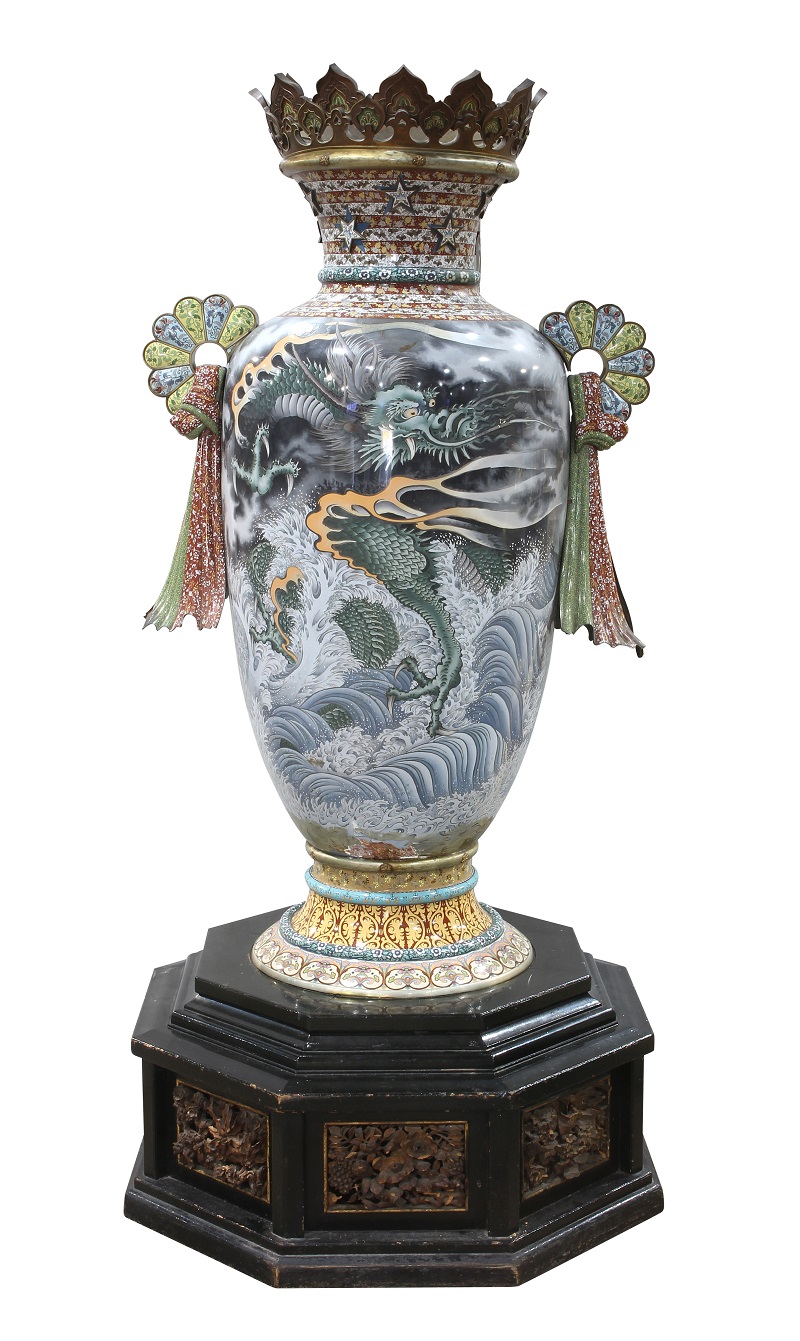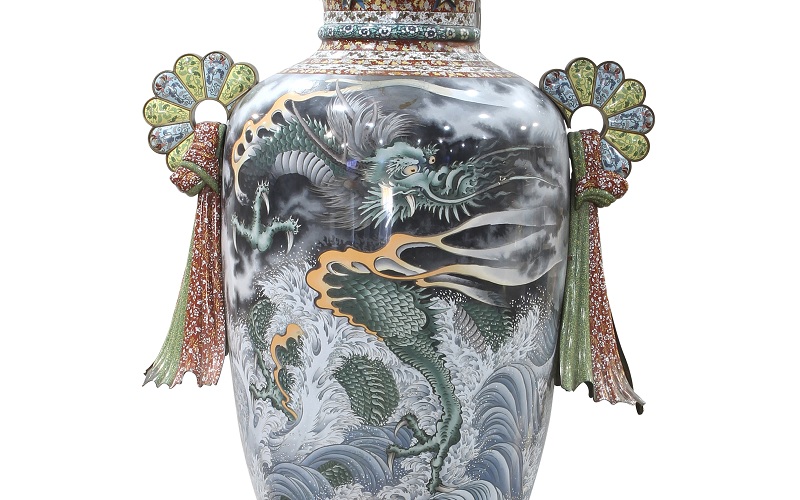A rare Japanese vase made especially for the 1893 World’s Columbian Exposition in Chicago has been hiding in plain sight in a California restaurant, reports the Chicago Tribune. The beautiful piece of World’s Fair history will go up for auction next month.

The recently identified Japanese vase from the 1893 World’s Fair, showing a dragon (symbolizing China) over waves. The vase decorated Spenger’s Fish Grotto in Berkeley, California, for many years. [Image courtesy Clars Auction Gallery.]
Dragon in the Restaurant
For many years, the 8-foot-tall vase featuring the images of a dragon and a plover above waves adorned the interior of Spenger’s Fish Grotto in Berkeley, California. The restaurant opened in 1890 according to the San Francisco Chronicle, but recently closed its doors. Plans to sell the decorative vase led to the discovery of its World’s Fair connection.
At the Columbian Exposition, the vase was displayed as part of a three-piece garniture consisting of two large vases and an incense burner known as a censer. Each was made in Japan using an enamel technique known as a cloisonné and reportedly were the largest examples this craft ever made at that time. While the other vase and censer have been known to reside in museum collections, this second vase was thought to have been lost or destroyed.
“Their figures of birds and animals are symbolic of the seasons and the virtues” writes one World’s Fair historian (Bancroft, 763), but the imagery also had important political messages. The dragon image on this second vase represents China.
“The Threat of Russia Imperialism” vase, showing an eagle (symbolizing Russia). [Image from the Nasser D. Khalili collection of Japanese Decorative Art.]
“The Threat of Russia Imperialism”
The companion vase, known as “The Threat of Russia Imperialism” and featuring the image of an eagle, resides in the Nasser D. Khalili collection of Japanese Decorative Art. (Snodgrass, 77). The museum describes the work as:
“a massive cloisonné enamel vase, with a pale grey ovoid body worked in silver wire with two eagles, one perched on a pine-branch, the other below, on a rocky ledge scattered with grasses, bamboo, and autumn leaves. The reverse with birds flying above turbulent water beneath branches of pine laden with snow. The neck decorated with alternate red and white bands of chrysanthemums and paulownia, the upper part with applied stars. The sides fitted with chrysanthemum-form handles hung with patterned swags of simulated drapery. The base decorated with formal foliate motifs.” (khalilicollections.org)
The censer depicts a group of chickens (symbolizing Korea) under a rising sun (symbolizing Japan) on one side and a blossoming cherry tree on the opposite site. The item is in the collection of Hirose Atsushi and exhibited by the Shosenkyo Ropeway Cloisonne Art Museum in Kofu, Yamanashi, Japan. (Snodgrass, 77)
A Kilburn stereoscope card titled “Japanese Vases, Value $50,000 Columbian Exposition” showing the three-piece cloisonné garniture in the Palace of Fine Arts in 1893. [Image from the Keystone-Mast Collection, UCR/California Museum of Photography, University of California at Riverside. Please contact UCR/California Museum of Photography for information about the copyright status of this item. Some materials in these collections may be protected by the U.S. Copyright Law (Title 17, U.S.C.). In addition, the reproduction, and/or commercial use, of some materials may be restricted by gift or purchase agreements, donor restrictions, privacy and publicity rights, licensing agreement(s), and/or trademark rights. Distribution or reproduction of materials protected by copyright beyond that allowed by fair use requires the written permission of the copyright owners. To the extent other restrictions apply, permission for distribution or reproduction from the applicable rights holder is also required. Responsibility for obtaining permissions, and for any use rests exclusively with the user.]
The largest examples of Cloisonné enamel ever made
Due to the political messages embedded in their designs, the Japanese vases were at one point going to be prohibited from inclusion in the Palace of Fine Arts exhibit and instead displayed in the Japanese pavilion of the Manufactures and Liberal Arts Building. According to research by Japanese historian Judith Snodgrass (author of Presenting Japanese Buddhism to the West: Orientalism, Occidentalism, and the Columbian Exposition. University of North Carolina Press, 2003), the vases were “a determined attempt the organisers of the Japanese exhibition made to put art in the service of politics at the Columbian Exposition.” (Snodgrass, 75).
The triptych was exhibited in the Art Palace, in the west end of the East Court of the ground floor, near the central rotunda. (Revised Catalogue, 392) The catalog of the Fine Arts department the Exposition offered this description of the display:
Suzuki, Shirozayemon (Yokohama). Two vases and an incense burner, in Cloisonné.
These three pieces are the largest examples of Cloisonné enamel ever made. The vases are eight feet eight inches high. Work upon them was begun in 1890 and finished in January, 1893. They were designed especially for exhibition at the World’s Columbian Exposition, and upon their completion were viewed by the Empress of Japan.
The designs on the vases were the idea of Mr. Shin Shiwoda, Special Counsellor for Arts of the Japanese Commission to the World’s Columbian Exposition. Their manufacture was undertaken by Mr. Shirozayemon Suzuki, of Yokohama, with the co-operation of Mr. Seizayemon Tsunekawa, at Nagoya. The original design was painted by Mr. Kanpo Araki, of Tokyo, and the black ink sketch on the copper was made by Kiosai Oda, of Nagoya. The men directly in charge of making the vases were Gisaburo Tsukamoto and Kihio ye Hayashi, of Toshima. The design for the wood carving was made by Setsuko Nishiyama, of Nagoya, and the carving was done by Kinzaburo Yeguchi, of Nagoya. The bronze American eagle was made by Yukimune Sugiura, of Tökyö. The general design represents the seasons of the year: the group of chickens typifying spring; the dragon, summer, and the two eagles, autumn; while on the reverse, with two red eagles, a winter scene is portrayed. The same design also symbolizes three virtueswisdom, honesty and strength, symbolized respectively, by the dragon, chickens and eagles.
Another idea conveyed by the front design is, that the dragon typifies China; the two eagles, Russia; the group of chickens, the Corean Islands, and the rising sun, the Empire of Japan; while the bronze eagle on the cover of the censer is the American eagle.
The silver stars inlaid on the horizontal red and white stripes on the top of the vases and censer are emblematic of the American stars and stripes, while the chrysanthemums and other Imperial floral emblems strewn on the stripes symbolize the close friendship between Japan and the United States. The handles of the vases are shaped after chrysanthemum leaves—the chrysanthemum being the imperial crest of Japan.
The blossoming cherry tree on the censer is symbolic also of spring. The full moon with the flight of birds, on one of the vases, symbolize summer and autumn. The lower portion of each vase shows bouquets of grasses of flowers native to Japan.
The pedestals on which the vases rest are made from keyaki, a hardwood tree grown in Japan, the wood of which is prized for its fine grain and durability. The pieces from which the pedestals are formed are two hundred years old, having been taken from a temple recently destroyed by an earthquake. The panels in the pedestals are carved from this wood and show seventy different specimens of flowers. (Revised Catalogue, 392-93.)
Entrance to Japanese Department of the Palace of Fine Arts. [Image from Hubert Howe Bancroft’s The Book of the Fair (The Bancroft Company, 1893).]
Auction of the Dragon
Clars Auction Gallery (5644 Telegraph Avenue, Oakland, CA) will offer the vase for sale on February 17, 2019, with a starting bid of $15,000 and an estimated value between $30,000 to $50,000. The auction house is “hopeful it could end up in an institution such as the Field Museum” according to the Tribune article.
UPDATE 2/18/2019: The vase sold at auction for $135,000 to New York collector.
UPDATE 3/1/2019: The vase was purchased by Nasser Khalili and will be reunited with its companion already in the Khalili Collections.
SOURCES
Bancroft, Hubert Howe The Book of the Fair. The Bancroft Company, 1893.
Revised Catalogue, Department of Fine Arts. W.B. Conkey, 1893.
Rosenberg-Douglas, Katherine “A rare vase from the 1893 Chicago World’s Fair was thought to be lost. Turns out it was at a California seafood restaurant.” Chicago Tribune, Jan. 8, 2019.
Snodgrass, Judith “Exhibiting Meiji Modernity: Japanese Art at the Columbian Exposition” East Asian History Number 31, June 2006, pp. 75-100.

